
Sense's Reminiscences
by Sense de Jong
- Geurt
- Tante Betje (by Sense)
- Tante Betje (by Truus)
- Miss Roozendaal
- Concert in Winschoten
- A baptism remembered
- My birdhouse
- War veterans
- Henk Smit - bass/baritone
- Stefan
- In memory of Herman - I
- In memory of Herman -II
- Remembering AK
- Our love for music
- Herman - Promoter of Christian Causes
- A Salem evening with Herman de Jong
- From Elsinore to Monschau
- A Danish Treat
- Glimpses of Thuringia and Saxony
- Domie and Hansie
- La Manche, Newfoundland
- Bermuda - Isle in the Sun
- 1932 and 1934
- 1940 - 1945
- Winschoten, Grace on the Venne
- 1948
- Johann Sebastian Bach
- From Generation to Generation
- Seven children and a harmonium
- K.P. - A Man of Enterprise
- Cuba and the tragedy of the MS St Louis
- It all began in Norwich, Ontario
Another site by Sense de Jong:
~ Hinne de Jong ~
A Chronicle
Sites by Henry de Jong:
~ Herman de Jong ~
Memorial
~ Newmaker Notes~
Writings, Pictures, Collections
~ AACS/ICS Niagara Conferences~
1970 - 1991
After perusing a previous article (see above: "From Elsinore to Monschau") it seemed good to me to write a more detailed account, most excellent Reader, of our 1994 visit to the Scandinavian island of Denmark. Do excuse me if I again dwell on certain events highlighted before. Most of what you will read now are matters that came to light upon further reflection. Here I pause and thank Wikipedia and other internet links.
Our choir, "The Cantata Singers" (from St. Catharines, Ontario), completed the first part of its European tour in July, 1994. We assembled in Leiden, the Netherlands, said goodbye to our Dutch hosts, and boarded the bus that would take us to Copenhagen.
The driver took us straight east to Germany. Soon we were on the south-north Autobahn that would lead us to Puttgarden, north of Hamburg, where we were to take a ferry across the sea to the island of Lolland, then (by bus) onto the large island of Sjaelland, all part of Denmark.
Some of us, especially I and the young people on board - all soccer fans - were on tenterhooks. While we were driving through the flat German country side, the Dutch national soccer team would be playing a scheduled game. This was the year of World Cup Soccer 1994. The host country was the United States. But there was no TV coverage on the bus. Tension gripped us all. Once we boarded the ferry, some of us, myself in the lead, stormed through the boat desperately trying to find the TV play-by-play of the Holland game. And, would you know it: no TV, no play-by-play!
Disappointed, we watched the world go by - beer in hand, sucking on my pipe - on the top deck. Only later did I realize that the ferry was navigating through the very same seas used during World War II by Hitler’s greatest and most feared battleship "Bismarck" to escape from its mooring in Gdynia, Poland, into the Atlantic Ocean. It stopped in Bergen, Norway, hiding in a fjord. The British Admiralty discovered her there when a daring Spitfire took pictures of the fjord. The "Bismarck" sank one of England’s greatest battleships, the "Hood ," in the north Atlantic, but she herself was sunk by an armada of ships on May 26, 1941, off the coast of France.
(Note: Also, during WW II , some 8,000 Jews were evacuated across these seas from Denmark to neutral Sweden. The Danish resistance movement with the help of ordinary Danish citizens did an incredible job saving so many people from the gas chambers. Whereas in the Netherlands nearly the entire Jewish population - close to 104,000 - were transported to German concentration camps, in Denmark over 99% of the Danish Jews survived the Holocaust! - sdj)
We arrived safely in Hvidovre, one of Copenhagen’s suburbs, where we were enthusiastically welcomed by our Danish guests. Some of them had been with a choir that had visited St. Catharines in Canada. We’ve gotten to know these people well and we were now returning the favour by visiting Denmark.
As reported in the above-mentioned article, Corrie and I were assigned to a wonderful couple, residing in Kastrup, close to the Copenhagen Airport, on the island of Amager. The other choir members disappeared to places unknown. But, we heard later, all of them enjoyed themselves immensely. We had to get used somewhat to the local cuisine. Our hosts surprised us with excellent dishes of Beef Stroganoff, and not just once either!
Our concerts went well. On Sunday, our choir was featured in the morning service of Hvidovre’s Lutheran Church. The entire service was conducted in the Danish language.
Our sightseeing trips with the choir were unforgettable. More about that later. First a bit about our own explorations of the island of Amager.
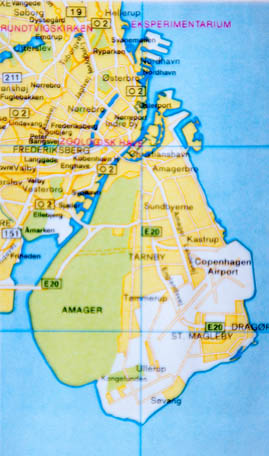
Amager and Dragor
Amager is a Danish island in the "Oresund." which is that body of water lying between Denmark and Sweden. The Danish capital, Copenhagen, or "Kobenhavn," is partly situated on Amager, which is connected to the much larger island of Sjaelland by five bridges. The international airport is on the east side of Amager.
Our hosts, Inger and Holger Clausen, living in Kastrup, were visibly nervous about how the Danish team would do on the World Cup Soccer stage. I could get into that! I was rather "verklemd" about how the Dutch boys would fare. They were quite relieved that I, too, was a soccer nut like themselves. Corrie noticed that whenever the Dutch team was playing, they were more interested in watching my antics and exclamations than following the game. But when the Danish team played, they, too, went crazy. All were happy!
Mr. & Mrs. Clausen explained to the two of us how to use the bus system. They said there was much to see and experience on Amager. And that’s how we discovered the beautiful town of Dragor and the nearby village of Store Magleby. It’s no wonder that Dragor is called the "pearl of Amager." It’s considered to be one of the best preserved maritime towns in Denmark!
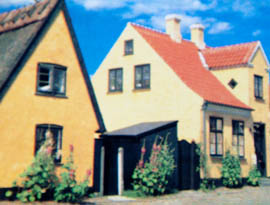
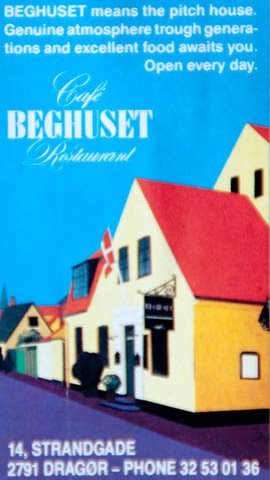
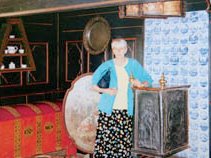
Dragor was founded in the 12th century and grew quickly as a fishing port. In 1370, the Hanseatic League was granted some trade privileges in the town. In the late Middle Ages many merchants from England, North Germany, Holland and Flanders met each other here. Hanseatic cities in the Netherlands, like Zutphen, Deventer, Harderwijk and Kampen had factories in Dragor under the patronage of the Danish king. In the pictoresque centre of Dragor there are streetnames like, would you believe it, Zytfensgade and Deventergade!
Also, in 1521, the Danish King Christian II invited a group of farmers from the Netherlands to settle on Amager for the purpose of growing vegetables for the royal household and to supply the Copenhagen market. And so, twenty-four families (mostly from Waterland, the Netherlands) arrived. They and their descendants settled in the village of Store Magleby. They flourished and soon started a Dutch Protestant Church. For almost 100 years the Word of God was preached here in the Dutch language. Dutch was also the language used in the area schools.
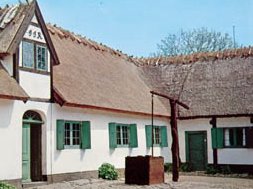
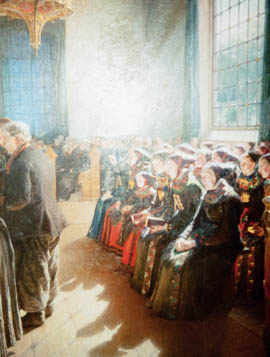
Corrie and I saw many evidences of how the Dutch had left their mark on Dragor and Store Magleby, not only in the style of architecture, but also in works of art and articles made by handicraft, etc. I took a picture of a period painting depicting what I took to be a group of Netherlanders congregating in one of their churches.
Visiting other sights
Using our touring bus, we explored the area north of Copenhagen. We briefly stopped at the homestead of Baroness Karen von Blixen - Finecke, whose pen name is Isak Dinesen, and who authored such books as "Out of Africa" and "Babette’s Feast." If you haven’t seen the movie version of "Babette’s Feast" you should treat yourself and rent the DVD!
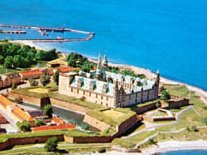
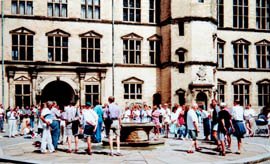
We then arrived at Helsingor (or Elsinore in English) on the northeast coast of Sjaelland. It is known internationally as the setting of William Shakespeare’s "Hamlet." The Danish king Eric of Pomerania built the "Kronborg Slot" in the year 1429 . The Shakespeare play is often performed in its courtyard. That was also the place where, on a sunny afternoon, our choir gave an impromptu performance for the benefit of the tourists present.
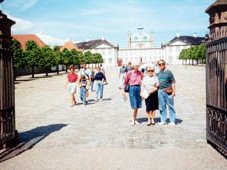
Later that day, we visited the "Fredensborg Palace" located on the eastern shores of Lake Esrum. It is the Royal family’s spring and autumn residence. However, the royals were not there when we arrived. This partially explains why we were rather free to roam the grounds and even parts of the palace. And, sure enough, we entered what appeared to be a chapel of some significance. We just needed to test the acoustics and promptly rehearsed nearly our entire repertoire from memory. In the afternoon we entered the beautiful city of Copenhagen.
We noticed the astronomical prices charged in the stores. We took one look at the prices in a regular McDonald’s outlet and we made a U-turn for the door. Hey, who can afford to live here!
(Note: As we wandered through its downtown core (including the fascinating Nyhavn area - the inner harbor), I could not help but be reminded of another WW II story. As a result, I began to look for the Copenhagen office of the Shell Oil Company. But I didn’t find it. The office complex had once been the notorious SD and Gestapo headquarters in Denmark’s capital city. A certain Ole Lippman, leader of the Danish resistance movement, asked RAF assistance in attacking these Nazi headquarters. Plans were drawn up for a spectacular precision attack that would, hopefully, free the many prisoners held in this building. These political prisoners were kept in the attic to prevent just such an attack, so the RAF had to try to bomb the lower level of the building. The attack came on March 22, 1945. All six planes (carrying one bomb each) in the first wave hit their target, but one of the aircraft crashed near the Frederiksberg school. Due to this crash four in the next wave of the following planes assumed the school was the target, and aimed their bombs at the school. Several teachers and some 15 students were killed, but 18 - of a total of 20 - political prisoners escaped. Also, the entire Gestapo archives were completely destroyed! - sdj)
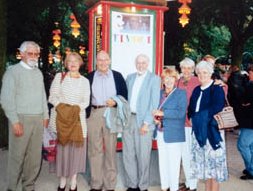
With an evening visit to Copenhagen’s "Tivoli Gardens" and a farewell party thrown by our gracious hosts our Denmark tour came to an end. The final concert in Europe took place on July 9, 1994, in the "St. Nicolaaskerk" in Vollenhove, the Netherlands, before an enthusiastic audience. Friends from far and near travelled from different parts in the Netherlands to this magnificent Reformed Church as a farewell gesture. Our participation the next morning in that church’s worship service brought our European choir trip to a fitting close.
[an error occurred while processing this directive]